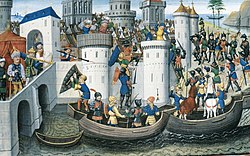Events
- January 27 – 28 – Byzantine emperor Alexios IV Angelos is overthrown in a revolution. [1]
- February 5 – Alexios V Doukas is crowned Byzantine emperor. [2]

Conquest of Constantinople by the Crusaders - April 12 – Sack of Constantinople: Crusaders enter Constantinople by storm and start pillaging the city as part of the Fourth Crusade. [1] Forces of the Republic of Venice seize the antique statues that will become the horses of Saint Mark. [3]
- May 16 – Baldwin, Count of Flanders, is crowned emperor of the Latin Empire a week after his election by the members of the Fourth Crusade. [4]
- Theodore I Laskaris flees to Nicaea after the capture of Constantinople, and establishes the Empire of Nicaea; Byzantine successor states are also established in Epirus and Trebizond. [5] [6]
- Boniface I, Marquis of Montferrat, a leader of the Fourth Crusade, founds the Kingdom of Thessalonica. [7]
- The writings of French theologian Amalric of Bena are condemned by the University of Paris and Pope Innocent III. [8]
- Tsar Kaloyan is recognized as king of Bulgaria by Pope Innocent III, after the creation of the Bulgarian Uniate church. [9]
- Valdemar II of Denmark is recognized as king in Norway. [10]
- Angers and Normandy are captured by Philip II of France. [11] [12]
- The Cistercian convent of Port-Royal-des-Champs is established. [13]
- The district of Cham becomes subject to Bavaria. [14]
- Hermann I, Landgrave of Thuringia submits to Philip of Swabia. [15]
- Beaulieu Abbey is founded. [16]
- The Channel Islands of Guernsey and Jersey decide, after a plebiscite of wealthy land owners, to remain with the English crown, after Normandy is recaptured by Philip II of France. [17]
- Landshut, Bavaria, is Founded. [18]
